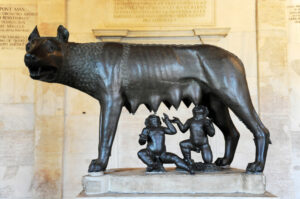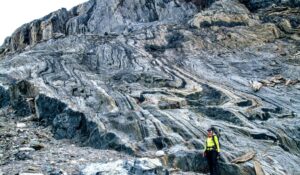The term ‘mega-tsunami’ is not the title of a budget sci-fi movie. It is a very real, rare, and dangerous phenomenon. It is much more powerful than the average tsunami and can form quickly, leaving little time to escape.
Alaska, 1958
On July 9, 1958, Howard Ulrich and his seven-year-old son were resting on their boat, enjoying a pleasant day in Lituya Bay, Alaska. They awoke to a rumbling sound and their boat moving violently. Soon they encountered a series of erratic waves created by a 7.8 magnitude earthquake. The earthquake was strong enough to be felt as far away as Washington.
To the pair’s horror, they witnessed the mountains shake, rocks fall into the ocean, and a giant wall of water heading straight for them. Luckily, their position at the far end of the bay bought them a couple of minutes to escape.

Lituya Bay. Photo: United States Geological Survey
However, the boat’s anchor was stuck to the sea bed. Ulrich gave his son a life preserver, preparing for the worst.
The wave’s force completely broke the chain, allowing Ulrich to maneuver, and the wave carried the boat to the middle of the bay. Ulrich battled smaller aftershock waves while trying to avoid uprooted trees and large chunks of ice. Eventually, he and his son managed to leave the bay, miraculously unharmed. Five other people were not so lucky.
Damage visible from space
The Ulrichs had survived a colossal 524m wave. This massive wave was the result of the Fairweather Fault, which happens to be underneath Lituya Bay. A powerful rockfall plunged 30 million cubic metres of rock and ice from the mountain and Lituya Glacier into the fjord. The displaced water swept up and the waves ripped throughout the fjord.
The power of this mega-tsunami was so incredible that the damage was noticeable from space. The water traveled up the forest line, uprooting trees and destroying vegetation. According to NASA, the tsunami wiped out 4km² of forest. Lituya Bay’s wounds are still apparent today.

Run-up at the Gilbert Inlet. Photo: United States Geological Survey
Unlike regular tsunamis that originate in the middle of the ocean, starting small before growing in size when they hit land, mega-tsunamis are instantaneous and result from impact events like meteor strikes and landslides. The water travels outward, much like when a pebble falls into a pond.
Lituya Bay is prone to mega-tsunamis. The area experienced mega-tsunamis in 1854, 1899, 1936, and 1958. This is because of its placement on the Fairweather Fault and the glaciers’ melting, unstable ice. Will we be seeing another mega-tsunami in the future? Scientists think it is very likely.






